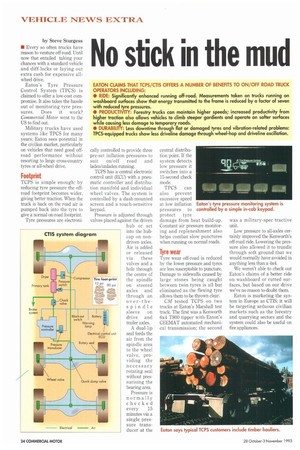No stick in the mud
Page 26

If you've noticed an error in this article please click here to report it so we can fix it.
EATON CLAIMS THAT TCPS/CTIS OFFERS A NUMBER OF BENEFITS TO ON/OFF ROAD TRUCK OPERATORS INCLUDING:
• RIDE: Significantly enhanced running off-road. Measurements taken on trucks running on washboard, surfaces show that energy transmitted to the frame is reduced by a factor of seven with reduced tyre pressures. • PRODUCTIVITY: Forestry trucks can maintain higher speeds; increased productivity from higher traction also allows vehicles to climb steeper gardients and operate on softer surfaces while causing less damage to temporary roads. • DURABILITY: Less downtime through flat or damaged tyres and vibration-related problems: TPCS-equipped trucks show less driveline damage through wheel-hop and driveline oscillation.
by Steve Sturgess • Every so often trucks have reason to venture off-road. Until now that entailed taking your chances with a standard vehicle and diff-locks or laying out extra cash for expensive allwheel drive.
Eaton's Tyre Pressure Control System (TPCS) is claimed to offer a low-cost compromise. It also takes the hassle out of monitoring tyre pressures. Does it work? Commercial Motor went to the US to find out.
Military trucks have used systems like TPCS for many years; Eaton sees potential in the civilian market, particularly on vehicles that need good offroad performance without resorting to large cross-country tyres or all-wheel drive.
Footprint
TCPS is simple enough: by reducing tyre pressure the offroad footprint becomes wider, giving better traction. When the truck is back on the road air is pumped back into the tyre to give a normal on-road footprint
Tyre pressures are electroni
cally controlled to provide three pre-set inflation pressures to suit on/off road and laden/unladen running.
TCPS has a central electronic control unit (ECU) with a pneumatic controller and distribution manifold and individual wheel valves. The system is controlled by a dash-mounted screen and a touch-sensitive keypad.
Pressure is adjusted through valves placed against the driven hub or set into the hub cap on nondriven axles. Air is added or released via these valves and a hole through the centre of the spindle on steered axles and through an over-thespindle sleeve on drive and trailer axles.
A dual-lip seal feeds the air from the spindle area to the wheel valve, providing the necessary rotating seal without pressurising the bearing area.
Pressure is normally checked every 15 minutes via a single pressure transducer at the central distribution point. If the system detects low pressure it switches into a 15-second check mode.
TPCS can also prevent excessive speed at low inflation pressures to protect tyre damage from heat build-up. Constant air pressure monitoring and repleneshment also helps combat slow punctures when running on normal roads.
Tyre wear
Tyre wear off-road is reduced by the lower pressure and tyres are less susceptable to puncture. Damage to sidewalls caused by large stones being caught between twin tyres is all but eliminated as the flexing tyre allows them to be thrown clear.
CM tested TCPS on two trucks at Eaton's Marshall test track. The first was a Kenworth 6x4 T800 tipper with Eaton's CEEMAT automated mechanical transmission; the second was a military-spec tractive unit Low pressure to all-axles certainly improved the Kenworth's off-road ride. Lowering the pressure also allowed it to trundle through soft ground that we would normally have avoided in anything less than a 4x4.
We weren't able to check out Eaton's claims of a better ride on washboard or rutted surfaces, but based on our drive we've no reason to doubt them.
Eaton is marketing the system in Europe as CTIS: it will be targeting arduous civilian markets such as the forestry and quarrying sectors and the system could also be useful on fire appliances.
































































































